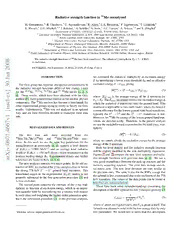
Radiative strength function in 96Mo reanalyzed PDF
Preview Radiative strength function in 96Mo reanalyzed
Radiativestrength function in96Mo reanalyzed M.Guttormsen,1∗ R.Chankova,2U.Agvaanluvsan,2E.Algin,5 L.A.Bernstein,2 F.Ingebretsen,1T.Lo¨nnroth,6 S.Messelt,1 G.E.Mitchell,3,4 J.Rekstad,1 A.Schiller,7 S.Siem,1 A.C.Larsen,1 A.Voinov,7,8andS.Ødega˚rd1 1 Department of Physics, University of Oslo, N-0316 Oslo, Norway 2 LawrenceLivermoreNational Laboratory, L-414, 7000 EastAvenue, Livermore, CA94551, USA 3 North Carolina State University, Raleigh, NC 27695, USA 4 Triangle Universities Nuclear Laboratory, Durham, NC 27708, USA 5 Department of Physics, Osmangazi University, Meselik, Eskisehir, 26480 Turkey 6 Department of Physics, A˚bo Akademi, FIN-20500 Turku, Finland 7 Department of Physics and Astronomy, Ohio University, Athens, Ohio45701, USA and 8 FrankLaboratoryofNeutronPhysics,JointInstituteofNuclearResearch,141980Dubna,Moscowregion,Russia 8 Theradiativestrengthfunctionsof96Mohavebeenreanalyzed.Theenhancedg strengthforEg <3−4MeV 0 isconfirmed. 0 2 PACSnumbers:PACSnumber(s):24.30.Gd,24.10.Pa,25.55.Hp,27.60.+j n a INTRODUCTION we estimated the statistical multiplicity at excitation energy J E byintroducinga lowerg -raythresholdE0 andaneffective 0 3 The Oslo grouphas reportedunexpectedenhancementsin excitationenergyE−Eentrygiving the radiative strength functions (RSF) of low energy g -rays ] for the 44,45Sc, 50,51V, 56,57Fe and 93−98Mo nuclei [1, 2, 3, hMgstati=(E−Eentry)/hEgi>E0, (1) x -e 4m]e.thTohde[s5e],rehsauvletsg,awinheidchbrhoaavdeibneteernesotbintaitnheednuwcilteharthpehyOssiclos where hEgi>E0 is the average energy of the g spectrum for l Eg >E0. TheEentryparametermimicstheexcitationenergyat c community. The96Monucleushasbecomea benchmarkfor whichthestatisticalg transitionsenterthegroundband. This u otherexperimentalgroupstryingtoverifyorfalsifytheOslo treatmentisapplicabletorareearthnuclei,wherethedetector n results. Unfortunately,96Mowas notanalyzedin an optimal [ systemefficiencyforthelowestgroundstatebandtransitions, way, and we have therefore decided to reanalyze these data typically the 4+ →2+ and the 2+ →0+ transitions, is low. 1 sets. However,for96Motheenergyofthelowestgroundbandtran- v 7 sitionsare detectedeasily. Therefore,in the presentanalysis 6 weusethestraightforwardexpressionforthetotalg -raymul- 6 REANALYZEDDATAANDRESULTS tiplicity 4 1. The two data sets were recorded from the hMgtoti=E/hEgi, (2) 0 96Mo(3He,3He′g )96Mo and 97Mo(3He,ag )96Mo reac- 8 wherewesimplydividetheexcitationenergybytheaverage tions. In this work we use the same key parameters for the 0 energyoftheg spectrum. normalizations as previously [4, 6], namely a level density : v of r (B ) = 71800 MeV−1 and an average total radiative Both the level density and the radiative strength function n Xi widthofhG (B )i=150meV(froms-waveresonances)atthe will be slightly modifiedby the new multiplicity expression. n Figures 1 and 2 compare the new level densities and radia- neutronbindingenergyB . Experimentaldetails andfurther r n tive strength functions with previous data [4, 6]. We see a a referencesarefoundinRefs.[4,5,6]. verygoodresemblancebetweenthepick-upreactionandthe Thenewanalyzesconcerntwomajorpoints. Intheoldex- inelastic scattering reaction. The error bars include statisti- tractionofRSF,weincludedtheg -rayenergiescloseorbelow cal errors only. The new level densities are very similar to the strong 778 keV 2+ →0+ ground band transition. This thepreviousones. ThesameistruefortheRSFs,exceptthat transitional region in the experimental (Eg,E) matrix is not theupbendislesspronouncedduetotheexclusionofthe778 properly subtracted in the first-generation procedure [7] and keVtransition. Thevaluesofthedatapointscanbefoundat isnowexcluded. http://ocl.uio.no/compilation/. The second point concerns the estimate of the g -ray mul- There have been some misunderstandings concerning the tiplicity as functionof excitation energy, which is an impor- descriptionoftheRSFupbendforlowg energiesgivenby[7] tant quantity both for normalizingthe g spectra with respect toeachotherandweightingthehigher-ordergenerationspec- 1 trainthesubtractionprocedure[7]. Inthepreviousanalyses, fupbend= 3p 2h¯2c2AEg−b, (3) whereA andbarefitparameters,andEg isgiveninMeV.The formulawaschoseninordertofitthelow-energydatabyonly ∗Electronicaddress:[email protected] twoparameters. We wouldliketostressthatthisdescription 2 No. DE-FG03-03-NA00074, No. DE-FG03-03-NA00076 and U.S. Department of Energy Grant No. DE-FG02-97- ER41042. [1] A. C. Larsen, M. Guttormsen, R. Chankova, T. Lo¨nnroth, S. Messelt, F. Ingebretsen, J. Rekstad, A. Schiller, S. Siem, N.U.H.Syed,andA.Voinov,Phys.Rev.C76,044303(2007). [2] A. C. Larsen, R. Chankova, M. Guttormsen, F. Ingebretsen, T. Lo¨nnroth, S. Messelt, J. Rekstad, A. Schiller, S. Siem, N.U.H.Syed,A.Voinov,andS.W.Ødega˚rd,Phys.Rev.C73, 064301(2006). [3] A.Voinov,E.Algin,U.Agvaanluvsan,T.Belgya,R.Chankova, M. Guttormsen, G.E. Mitchell, J. Rekstad, A. Schiller and S.Siem,Phys.Rev.Lett93,142504(2004). [4] M.Guttormsen,etal.,Phys.Rev.C71,044307(2005). [5] A.Schiller,L.Bergholt, M.Guttormsen, E.Melby, J.Rekstad, and S. Siem, Nucl. Instrum. Methods Phys. Res. A 447, 498 (2000). [6] R.Chankova,etal.,Phys.Rev.C73,034311(2006). [7] M.Guttormsen,T.Ramsøy,andJ.Rekstad,Nucl.Instrum.Meth- odsA255,518(1987). FIG.1:Experimentalleveldensitiesfromthe(3He,a )(filledcircles) andthe(3He,3He’)(open circles)reaction. Thedatafromthenew analysisiscomparedwithpreviouslypublisheddata[6]. should notbe used for g energieslower than the experimen- tal data points. In the extremecase whenEg →0, it is clear that the description is totally unrealistic as it gives wrong g multiplicity. SUMMARYANDCONCLUSIONS The radiative strength function of 96Mo has been reana- lyzedgivingaslightlylesspronouncedenhancementatlower g -ray energies. The data points at and below the 778 keV 2+ →0+ transition have been omitted. Since extraction of leveldensityiscoupledtotheradiativestrengthfunction,new leveldensitieshavealsobeenpresented. Financial support from the Norwegian Research Council (NFR) is gratefully acknowledged. Part of this work was performedundertheauspicesofthe U.S.DepartmentofEn- ergybytheUniversityofCalifornia,LawrenceLivermoreNa- tionalLaboratoryunderContractW-7405-ENG-48.A.V.E.A, FIG.2: Experimentalradiativestrengthfunctionsfromthe(3He,a ) U.A,andG.E.MacknowledgesupportfromtheNationalNu- (filled circles) and the (3He,3He’) (open circles) reaction. The clearSecurityAdministrationundertheStewardshipScience data from the new analysis is compared with previously published Academic AlliancesprogramthroughDOE Research Grants data[7].
